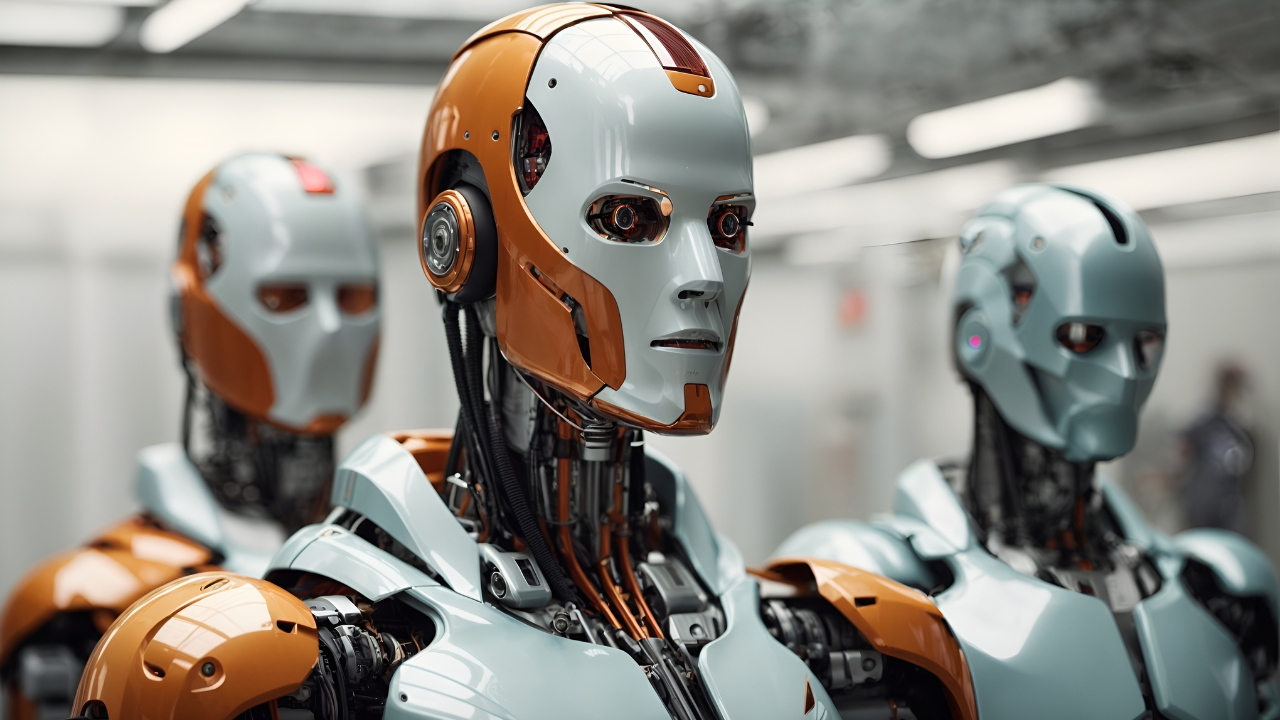The advent of generative AI has revolutionized numerous fields, and its impact on robotics is particularly transformative. No longer confined to pre-programmed routines, generative AI in robotics is enabling machines to gain unprecedented levels of autonomy, adaptability, and creativity. By leveraging AI’s ability to generate new content, designs, and behaviors, robots are evolving into more intelligent and responsive systems. As of mid-2025, the synergy between generative AI and robotics is ushering in a new era of intelligent automation.
Generative AI: The Creative Engine
At its core, generative AI refers to artificial intelligence models capable of producing novel outputs, such as text, images, code, designs, or even behaviors, based on patterns learned from vast datasets. Unlike discriminative AI, which primarily classifies or predicts outcomes from existing data, generative AI creates something entirely new. Technologies like Generative Adversarial Networks (GANs), Variational Autoencoders (VAEs), and Large Language Models (LLMs) are foundational to generative AI, enabling machines to understand complex relationships and extrapolate to unseen scenarios. This creative capacity is what makes generative AI a game-changer for robotics, allowing robots to move beyond rigid programming into more flexible and human-like interactions and problem-solving.

Generative AI in Robotics: Redefining Automation
The integration of generative AI in robotics is accelerating the deployment of autonomous systems and tackling some of the most challenging aspects of robot development. Here's how:
1. Robot Design and Optimization
It can design novel robotic components, structures, and even entire robot bodies. By setting specific performance criteria (e.g., maximizing strength, minimizing weight, or optimizing for a particular task), generative AI algorithms can explore millions of design permutations, producing solutions that human engineers might not have conceived. This “generative design” process significantly streamlines prototyping and enhances robot efficiency and effectiveness.
2. Motion Planning and Control
Traditionally, programming complex robot movements is arduous. Generative AI can generate highly optimized and natural-looking robot motions from high-level commands. For instance, an LLM can translate a natural language instruction like “pick up the blue cup and place it on the top shelf” into a sequence of atomic tasks and then generate the precise robotic arm movements and grasp configurations needed to execute them smoothly and efficiently. This dramatically reduces programming time and makes robots more adaptable to unstructured environments.
3. Enhanced Human-Robot Interaction (HRI)
It enables robots to interact with humans in more natural and intuitive ways. By generating coherent and contextually appropriate speech responses, gestures, and expressions, robots can become more effective collaborators in various settings, from manufacturing floors to customer service. This is particularly crucial for collaborative robots (“cobots”) that work alongside humans.
4. Synthetic Data Generation for Training
Training robust robotic AI models often requires massive amounts of diverse data, which can be expensive and time-consuming to collect in the real world. Generative AI can create highly realistic synthetic data (e.g., sensor inputs, environmental conditions, object variations) for training robots in simulations. This synthetic data augments real-world datasets, allowing robots to learn new behaviors, strategies, and responses in a safe, controlled, and scalable virtual environment, and then transfer that learning to the physical world (“sim-to-real” transfer).
5. Adaptive Behavior and Problem Solving
Robots powered by generative AI can learn from their experiences and adapt to unforeseen circumstances in real time. If a robot encounters an unexpected obstacle or a new task, generative AI can help it generate novel solutions or adjust its behavior without explicit reprogramming. This makes robots more robust and versatile in dynamic and unpredictable environments.
Buy Generative AI Products: A Growing Market for Robotics
The market for generative AI products, particularly those tailored for robotics, is experiencing rapid growth. Companies are developing specialized software platforms, AI models, and integrated hardware-software solutions that leverage generative AI for various robotic applications. Businesses looking to buy generative AI products for robotics can find:

- Simulation & Digital Twin Platforms: Software that uses generative AI to create realistic virtual environments for robot training and testing (e.g., NVIDIA Isaac Sim).
- Generative Design Software: Tools that apply generative AI to optimize the physical design of robot components (e.g., Autodesk Fusion 360, though not exclusively for robotics).
- AI-Powered Robot Programming Tools: Software that simplifies robot programming through natural language interfaces or automated code generation.
- Pre-trained Models for Robotics: Generative AI models specifically trained on robotic datasets for tasks like object recognition, manipulation, or navigation.
Major tech companies and specialized AI/robotics startups are vying for market share. As generative AI matures, we can expect to see more off-the-shelf solutions that empower companies to integrate advanced AI capabilities into their robotic deployments.
Generative AI Research: Pushing the Boundaries
Generative AI research in robotics is a highly active and interdisciplinary field. Current research trends include:

- Foundation Models for Robotics: Developing large-scale generative AI models that can serve as general-purpose “brains” for robots, capable of performing a wide array of tasks and adapting to diverse environments with minimal retraining.
- Data Efficiency: Researching methods to train generative AI models for robotics with less real-world data, addressing the challenge of data scarcity in complex robotic tasks.
- Long-Horizon Task Planning: Leveraging generative AI for decomposing complex, multi-step tasks into manageable sub-goals, enabling robots to perform intricate sequences of actions over extended periods.
- Ethical AI in Robotics: Addressing critical ethical considerations related to the safety, bias, transparency, and accountability of autonomous robots powered by generative AI, especially as they become more integrated into daily life.
These research efforts are crucial for overcoming current limitations and unlocking the full potential of generative AI in robotics.
OpenAI Generative AI: Influencing the Robotic Landscape
OpenAI, a leading AI research organization, has significantly influenced the development and application of generative AI, and its work has direct implications for robotics. While OpenAI's primary focus has been on large language models like GPT and image generation models like DALL-E, the underlying principles and architectures are highly transferable to robotics.

OpenAI's research on reinforcement learning and generalization provides valuable insights for training robots to perform complex tasks in diverse environments. Their emphasis on developing AI that can understand and respond to human instructions in natural language directly contributes to more intuitive human-robot interaction. Although OpenAI doesn't produce physical robots themselves, their foundational generative AI models and research methodologies serve as powerful tools and inspirations for robotics researchers and companies worldwide, accelerating the pace of innovation in generative AI in robotics.
US Generative AI: A Global Hub for Robotics Innovation
The US generative AI landscape is a vibrant hub of innovation, with significant investment and research activity shaping the future of robotics. Major tech giants, well-funded startups, and leading academic institutions are all contributing to the rapid advancements in generative AI for robotics.
1. NVIDIA
A prominent player, NVIDIA provides hardware (GPUs, AI platforms like Isaac) and software (Isaac Sim for robotics simulation, generative AI models) that are critical for developing and deploying AI-powered robots. They are heavily invested in creating physically accurate simulations and synthetic data generation tools that leverage generative AI for robot training.
2. Boston Dynamics & Agility Robotics
These leading humanoid and quadruped robot companies are increasingly integrating generative AI to enhance their robots' balance, navigation, perception, and interaction capabilities, moving beyond pre-programmed movements to more adaptive behaviors.
3. Academic Research
Universities across the US, such as Stanford, MIT, Carnegie Mellon, and UC Berkeley, are conducting cutting-edge generative AI research specifically tailored for robotics, pushing theoretical boundaries and developing practical applications.
4. Funding and Startups
The US has a robust venture capital ecosystem that is heavily investing in generative AI and robotics startups, fostering a dynamic environment for new companies to emerge and scale their solutions. This strong financial backing ensures that generative AI in robotics remains a top priority.
This strong ecosystem makes the US a global leader in integrating generative AI into robotic systems, with a clear focus on applications ranging from manufacturing and logistics to healthcare and defense. The future of generative AI in robotics promises a world where intelligent machines can adapt, learn, and create, revolutionizing industries and improving daily life.









